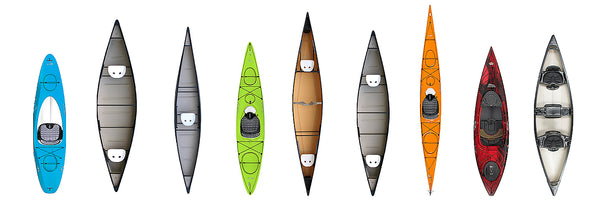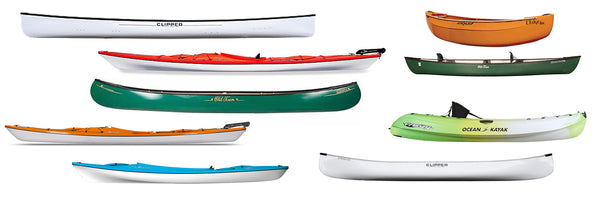Choosing a canoe or kayak - 3 important things to look at
Looking for a canoe or kayak? This post will take you about 2 minutes to read. It covers 3 ways to look at a canoe or kayak that will tell you most about how the boat will feel in the water.
If you are considering buying a new or used boat, or simply choosing which boat to paddle out of a fleet, look at these 3 characteristics and you'll be able to make a sophisticated choice.
1. Look at the boat from the top
The top-down view of a boat shows the ratio of length to width. Generally speaking, long narrow boats will be faster and less stable. Shorter, fatter boats are more suited to recreational use and will be slower but more stable.
Canoes that are wider at the front will tend to ride waves more buoyantly, and if the hull is flared here this will also deflect waves better. Canoes that are more narrow at the front will tend to cut through waves, which is faster and more efficient but can get you pretty wet if you're in big water.

2. Look at the boat from the side
Look at the profile of the boat. If it was sitting on the floor, how much of the hull would be contacting the floor? The entire length (little rocker), or only the middle part (large rocker)?
A boat with little rocker will track straighter, meaning you don't have to work as hard to make it go in a straight line, but will be more difficult to turn. A boat with more rocker will maneuver more easily but will not hold a straight line as well.
The profile also shows you how deep a boat is. The more boat there is sticking up out of the water the bigger the capacity and the more protected paddlers are from the water, but the more there is to catch the wind.

3. Look at the shape of the boat's cross section
Say you cut the boat in half across the middle width: what does that shape look like? If it has a flat bottom, you've got a stable but slow boat. Round bottoms will feel quite dynamic and will be significantly faster (read: less work to paddle). A slight V is a mix of stability and speed and generally tracks well. A boat with flat sections and sharp angles (hard chines) will have decent speed and tracking, and once you learn the feel will be stable when leaned onto one of the flat sections of the hull.
When in waves, a rounder-bottomed boat will keep your body more upright than a flat-bottomed boat (which wants to stay flat on the surface of the water).

Other factors to consider when choosing a boat
There are definitely other things to consider when looking at boats, such as materials (affects weight and durability), comfort (such as seats, foot space), extra features (rudders, skegs, hatches, footbraces, rigging) and how easily you will be able to transport it to your paddling location (car-topping).
Understanding the 3 views above however gives you the ability to pick out a boat that will paddle the way you want it to, which is fundamental.


Comments
Leave a comment